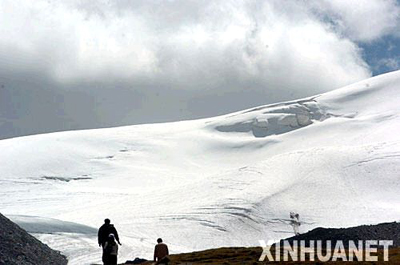China is to build a standing observation station to monitor melting of its longest glacier range at the edge of the world's top plateau.
The Chinese Academy of Sciences (CAS) planned to construct the scientific station at the foot of the Qilianshan Mountains, at the north rim of the Qinghai-Tibet plateau, the Science Times reported on Tuesday.
A recent scientific survey by the CAS Institute of Cold and Arid Regions Environment and Engineering showed the glaciers were significantly receding with global warming. Building a standing observation station was in response to the urgent need for constantly monitoring the speed of the glacial melt.
Qin Xiang, a senior researcher at the CAS institute who was recently named to head the proposed station, said the west section of the Qilianshan Mountains was an ideal place to observe ecological and environmental systems of the glaciers.
Previously, China organized three large-scale scientific surveys on the glaciers in the late 1950s, 1984 and earlier this year.
The latest survey revealed the worst glacial recession appeared at the Yanglonghe glacier No. 1 at the Qilianshan Mountains. It had receded 260 meters when compared with the data obtained from a similar survey 23 years ago, Liu Shiyin, a principal investigator from the same CAS institute, said.
Liu and his research team have completed the latest survey on China's glaciers and their change in a wide frozen area covering more than 20,000 square kilometers.
After using radar to measure the thickness of the Qiyi Glacier in the Qilianshan Mountains, he said the mass had been sliced by an average of 19.6 meters, with a thickness reduction of at least 50 meters, the newspaper reported.
As data gained from the latest survey was primarily processed, Liu said the glaciers in this region, the best studied glacial area in China, had receded 7.4 percent compared with the 1984 measurements.
The Ili River Valley, the Junggar Basin and the upper reaches of the Yarlung Zangbu River saw the most rapid glacial recession, 18 percent less than those measured in 1984, the newspaper said.
"The glaciers were significantly reduced by global warming resulting from continuous human-activity-related climate change," Liu said. He added that the glacial recession would affect farming irrigation and therefore people's livelihood in a vast area of north and central China.
The glaciers were also important water sources for many hydropower plants built on major rivers in north China.
The observation station was expected to monitor atmospheric conditions, glaciers melting, tundra, frozen earth plants and hydrological conditions near the Qilianshan Mountains, senior researcher Qin said.
(Xinhua News Agency December 25, 2005)








